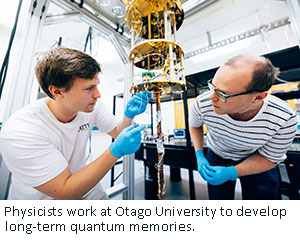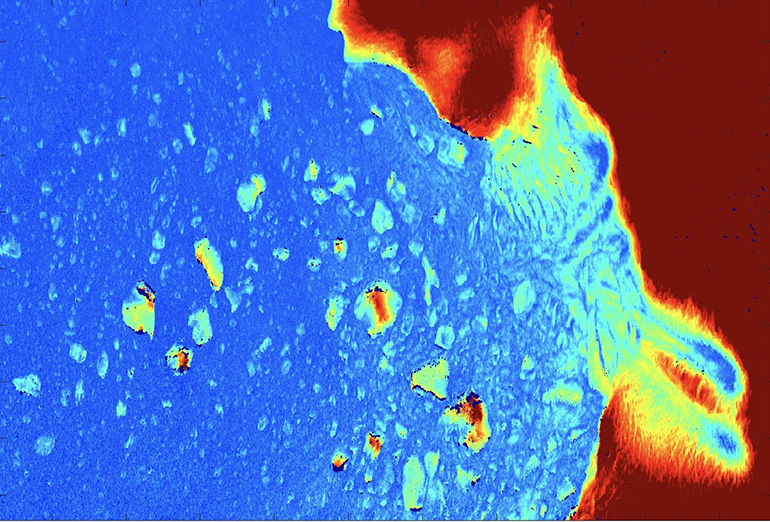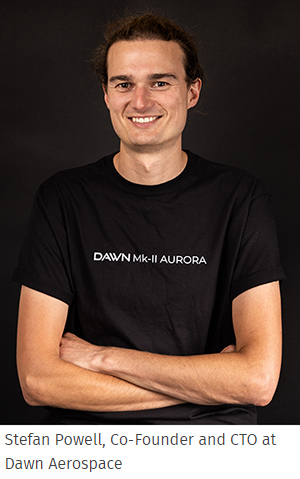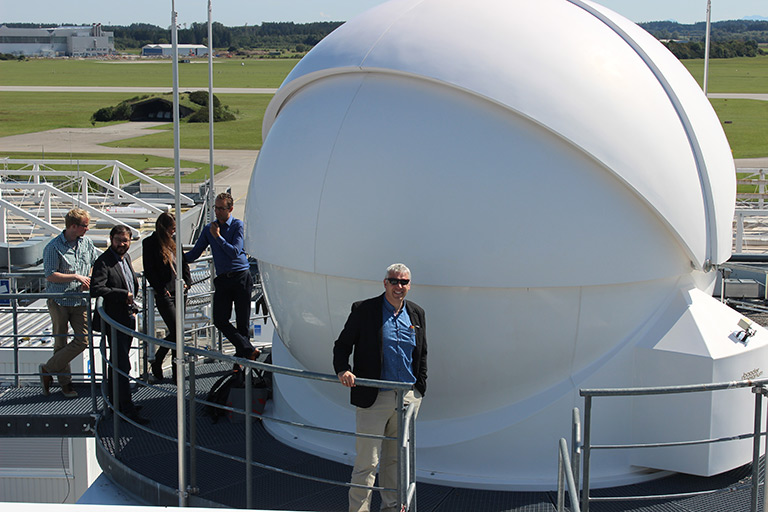International research projects
In October 2018, MBIE and the German Aerospace Centre (DLR) signed a Letter of Intent at the International Astronautical Congress (IAC) to enable joint research collaboration, focused on space systems, earth observation technologies and applications, transport technologies and energy technologies.
On this page
MBIE and DLR have now agreed to jointly support a set of 8 research projects, with the New Zealand research teams receiving a total of NZ$8 million (GST excluded) over 3 years.
This funding will support the development of aerospace technology capability, establishing enduring research partnerships with Germany and jointly contributing to solving global economic, environmental, and social challenges.
University of Otago
Project — Long term quantum memories for satellite quantum communication
Led by Associate Professor at Otago University Jevon Longdell
Making quantum memories
Distance is sparking innovation at Otago University and the German Aerospace Centre (DLR), where researchers are collaborating across oceans to advance communications in space.
Long-term quantum memories for satellite quantum communication is one of eight projects being funded under a joint MBIE-DLR research programme. It aims to tackle challenges faced in communicating over long distances and intermittent links by marrying DLR’s single photon sources with Otago’s crystal-based quantum memories. But what does all this mean?

From classical to quantum
Classical computers register information in one of two states: on or off – kind of like a light switch. These states are represented by a one or a zero and each one or zero is known as a bit – the smallest unit of data.
Quantum computing changes the game through a phenomenon called ‘superposition’. Here, the smallest unit of data can take on states that are a superposition of one and zero at the same time. These units are known as qubits.
Associate Professor at Otago University Jevon Longdell is leading this project from the New Zealand side, and says it is these qubits that his team is working to harness and store.
“If you can make a computer that uses and manipulates these very precisely defined quantum states, then you can solve some problems much, much faster than you can with a classical computer,” he explains. “And if you are doing communication with these states – which is the most immediately relevant thing for our project – you can know if someone’s listening.”
However, the very characteristics that enable this speed, accuracy and security also pose unique challenges for long-distance transmission.
The challenge
Transmitting data across vast distances inevitably leads to losses and degradation - unless you can break up the journey.
“If you want to do long distance quantum communications, you can’t use regular repeaters because they would ruin your quantum states when you try to amplify them,” Dr Longdell says.
“You can make quantum repeaters that enable you to do a clever trick called entanglement swapping, but those require quantum memories.”
In broad terms, entanglement is the mind-bending quantum mechanics phenomenon where two photons behave as one unit even when physically separated. You cannot measure something about one photon without affecting the other photon in the pair, which is what makes it secure.
Entanglement swapping is the process by which one particle in the photon pair becomes entangled with a third particle. This new photon particle subsequently becomes entangled with the first particle without any direct interaction.
The solution that Dr Longdell and his collaborators are working on aims to combine special crystals that absorb photons and release them again on demand, with a light source that generates these entangled photon pairs.
Using these two building blocks they will store one photon of the entangled pair, allowing the other entangled photon to then be sent somewhere else in an entanglement-based quantum communication network.
Progress to date
As of April 2024, Dr Longdell reports that the photon pair sources have been completed. They were built at the DLR in Berlin and are now working in the Otago lab. The focus has now switched to the quantum memories.
“These are now operating storing classical light, but we need to clean up a few things to make them suitable for the single photons provided by the sources. We are also setting up the systems to ensure that the single photons’ wavelength precisely matches that on the memories,” he says.
Next steps
So, when can we expect this Kiwi-German innovation to be orbiting above us?
“I’m forever amazed at how fast things develop in the quantum information space,” Dr Longdell says. “At the end of this grant, we hope to have pushed this up to a level where it’s worthwhile to start designing satellites and missions around our quantum memory technology.
“It’s then about the length of time needed to design a satellite. If it happens in five years, I would be very happy. We are looking forward to our quantum memory technology moving much closer to being deployed.”
ReSTORe Lab Ltd
Project —Takahe: Advanced Object Detectability in a Water Clutter Environment Using InSAR
Led by Dr Delwyn Moller, CEO ReSTORe Lab Ltd, Wanaka, New Zealand
Restore Lab Ltd. in collaboration with the German Aerospace Center (DLR) is developing a new method for detecting small, metre-class artificial or potentially hazardous objects such as sea ice in vast water expanses from space or the stratosphere using interferometric synthetic aperture radar. The project, named Takahē (Tandem Ka-band satellites and High altitude Explorer), is funded under a Ministry of Business, Innovation, and Employment Catalyst research programme to collaborate with DLR on problems of mutual interest, and aims to create to a new class of operational, high resolution maritime domain awareness products available to stakeholders in New Zealand and worldwide.
Recently DLR provided the opportunity to acquire proof-of-principle observations from their current TanDEM-X synthetic aperture radar dual satellite mission. With significant and generous support from Coastguard Wānaka, Restore deployed a mid-sized vessel and small manmade objects on Lake Hāwea during TanDEM-X over flights. The early results show significant promise toward measurement premise validation.
Restore Lab is a Wānaka, New Zealand-based research company that focuses on the development of new, advanced remote sensing methods and systems for terrestrial and maritime applications.
For more information, please contact info@restorelab.co.nz.

SAR imagery showing bergy-bit outflow from a marine terminating glacier in Greenland. Colour indicates height and clearly allows discrimination of ice from navigable water. Data was collected using the NASA JPL GLISTIN system for the Oceans Melting Greenland (OMG) mission and is analogous to the measurement capabilities targeted by Mission Takahe.
Dawn Aerospace
Project — researching nitrous (N2O)-based satellite propulsion technology for sustainable space transportation
Led by Stefan Powell, CEO and CTO of Dawn Aerospace.

What does this scientific cooperation represent for Dawn’s long-term mission and some of the important societal challenges you’re looking to tackle?
Dawn Aerospace has a vision of sustainable and scalable space transportation at every step, from getting things to space, moving them around and bringing them back to Earth.
Currently, the dominant chemical used for in-space transportation is a toxic propellant called hydrazine. Our first task in making transportation in space simpler is to replace this fuel with something less toxic, and more easily accessible for the many new companies wanting to build satellites. Fuelling a satellite with hydrazine comes with a $500,000+ price tag, which is more than some satellites’ total build and launch cost. It’s an expensive, prohibitive and highly carcinogenic product that has no place in the new space industry.
Dawn is already beating hydrazine systems on price, lead time, safety and accessibility with green propulsion technology but, to fully replace hydrazine, we have some work to do on performance. Our thrusters are fast on track to being the ‘green’ standard for the small satellite industry, but we know many other applications would benefit from these propellants, including larger satellites, as well as deep-space and lunar missions. The work we are doing with DLR is to progress the fundamental understanding of these propellants so we can push thruster limits, improve performance and then replace hydrazine once and for all.
What outcomes do you hope to achieve through this collaboration?
The concept of N2O-based bi-propellant propulsion systems is not new. It has been around for a long time and extensively tested on the ground. The problem is that these engines are hard to get right and the thermal kinetics are a real pain.
Some of the nitty gritty details, like how N2O acts as a coolant, are not well understood. Exotic materials and film cooling are typically used to solve this problem, but we additively manufacture our thrusters as a single piece using Inconel alloy 718. We want to keep doing this because the low cost, scalability and speed of production are major advantages. What is new is that we’ve flown the thrusters in space, something that had never been done before, proving our method of design, manufacture and verification works. Now we’re optimising the engine to be the best it can be.
To build the best nitrous engines in the world, there are knowledgeable gaps to fill and a lot of the new research to conduct. We've made significant strides in our understanding of the thermal properties of nitrous oxide through scientific cooperation with DLR, which is very cool.
International collaborative research projects often provide findings beyond what one team could achieve alone. In what areas do you hope to gain more skills and a better perspective of the topic you are researching?
DLR are experts at fundamental research and have the authoritative expertise in combustion research. This collaboration gives us a direct line to the world’s best researchers and minds in the business.
At Dawn, we’ve proven ourselves in applying knowledge to build useful products that have significant commercial value. Research benefits from commercial feedback to assess that knowledge is valuable and new products need research to make large changes from the status quo, or else only incremental changes are possible. Together, we can find solutions to extremely difficult problems that we couldn’t do alone, then turn that knowledge into world-changing products.
How will this collaboration change how you operate in the future?
We have customers asking us to support advanced deep-space missions like GTO (Geostationary Transfer Orbit) and GEO (Geostationary Orbit) transfers, Lunar, Mars and asteroid insertions. These high-performance missions benefit substantially from every last percent of performance so, naturally, there is a desire to squeeze more out of them. Collaborating with DLR will help make these missions a reality and allow green propulsion to be more universally applied in space.
Talk to us about the match between applied academia and industry and what this means for both.
Dawn and DLR have come together to create positive results for both entities. It’s a great story of bridging industry and applied academic pursuits. As the industrial project participant, we get access to knowledge and experience we usually wouldn’t have access to. For DLR as the applied academia project participant, they receive a timely industry problem and can apply their research to a product with a high technology readiness level and relevance in the market. DLR has several PhD students involved in the various work packages we’re doing together who get opportunities to include high-pedigree research in their theses.
We’ve become the world leader in commercialising N2O-based propulsion systems and are regularly launching hardware to space. We’re delivering systems for orbital transfer vehicles (OTVs), Earth observation, internet, IoT constellations and more. It’s exciting that DLR’s research outcomes can fly on these spacecraft.
How is the collaboration going and what’s next?
Our partnership has continued at pace since the collaboration began.
To massively oversimplify, the 2 things that matter with rocket engines are how well the propellants burn and how hot the engine gets. Our work has broadly focused on these 2 areas and we're already putting the learnings into practice to improve the performance of our thrusters. While there is a lot of data available that describes the heat transfer properties of various liquids, there is nothing specific for N2O.
Together with DLR, we've built a first-of-its-kind heat transfer correlation data set specific to our thruster conditions. This allows us to more accurately predict the performance of new designs and bring them to the test bench – and the market – faster. In November 2023, we completed the data set for N2O gas and we're now extending this work to multi-phase (liquid and gas).
The second work package looks at the combustion side of a rocket engine. As is often the case with complex R&D, this work package looks quite different from what we initially planned. We initially looked at complex chemistry schemes to understand the reaction rate of our propellants, but we've switched the focus to injector design. It's a testament to our great partnership that we can adapt plans as necessary.
This project has been an amazing kick-start for our relationship and has led to several other projects with DLR. The data we've collected to date has already led to real performance improvements in our hardware, and with so much more to learn, we're excited about what's still to come!
University of Auckland Research Team
Project — using laser light technology to transmit data to Earth
Led by Dr Nicholas Rattenbury, from the Department of Physics in the Faculty of Science.
“We are working on developing optical communications between space satellites and Earth. Using optical wavelengths for communication offers substantial benefits in terms of bandwidth and security. This research will benefit from New Zealand's expertise in photonics, quantum mechanics, optical telescope observatory design and operations, and will develop our research relationships with strategic international partners like the DLR.”
Dr Nicholas Rattenbury

Dome of the Optical Ground Station of DLR's Institute for Communication and Navigation in Oberpfaffenhofen. Left to right: Jan Krecke (PhD candidate, UoA), Andrew Austin (UoA), Olga Trivailo (DLR) Christian Fuchs (DLR-IKN) and Nicholas Rattenbury (UoA) in the foreground. Photo by John Cater (UoA).
International collaborative research projects often provide findings beyond what one team could achieve alone. In what areas do you hope to gain more skills and a better perspective of the topic you are researching?
We will be gaining new insights into free-space optical communications, laser communication instrumentation, satellite tracking, and ground station operations.
What unique benefits do you see as a result of working with DLR researchers and scientists as opposed to those from other countries?
The DLR has a long history of scientific research and innovation in space science and engineering, and a proven track record of engaging with their research partners. They have been able to influence and promote the DLR-NZ collaboration with their policy makers and gain support within their team to foster this new relationship.
How will this partnership help you expand the breadth of your research?
My research portfolio is expanding into a thoroughly new area. My expertise in telescope operation, control and use for astronomical research, coupled with broader research into small satellite mission design for science projects, has widened my field of operations into space science and engineering; a significant rescoping of my career path.
Due to Covid travel restrictions this partnership was established solely online without meeting in face-to-face situations, what were some of the challenges and opportunities you came across?
We had met in person and discussed research opportunities with DLR before the DLR-NZ Catalyst project was established. This personal interaction made the subsequent discussions, planning and interactions over remote video teleconferencing so much easier. The time difference between NZ and Germany means that our video conferences are usually in the early evening, New Zealand time, which is not an issue. We have enjoyed a great relationship via Zoom. Having meetings online means I can easily extend invitations to additional associated researchers – and in turn, those additional researchers are more likely to join in on a Zoom call rather than attending an in-person meeting.
These projects tackle important societal challenges; how will this collaboration give you an advantage in this area?
Our DLR partners are world-leaders in the field of research – and know how to apply scientific breakthroughs to the real world. They know how to develop standards suited to the technology, its use and development; and can ensure that those standards meet the needs of public, commercial, industrial, political and research stakeholders.
What outcomes do you hope to achieve through this collaboration?
I hope that this collaboration will be the start of an enduring relationship where big things happen. I see it as just the beginning – allowing the work to continue and grow, so that more researchers have the opportunity to work on advanced free-space optical communications and ground station operations. I also hope that this relationship will be an example of how NZ-DLR research links can be strengthened in general.

